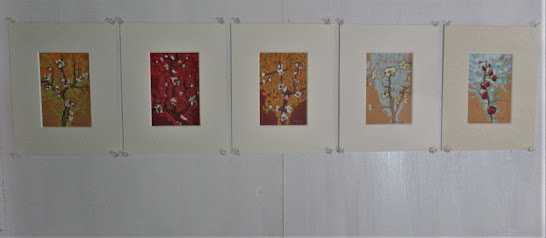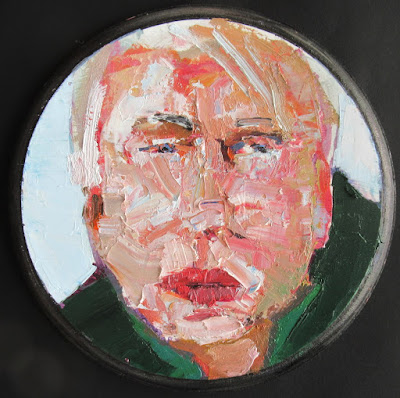Peter Davidson
Portraits
Paintings and
Drawings - via the internet
2 Dogs Art Space
Akashi Japan - March 2021
A four-decade journey
with the latter years having the influence of Japanese art exhibits itself
through studio praxis as the strangeness of natural vision
This exhibition at 2
Dogs Art Space Akashi Japan demonstrates the overlapping influences of eastern
and western aesthetic cultures on my painting and drawing systems.
Twenty years of
living in the Kansai region of Japan, together with the benefit of viewing the
many great master exhibitions throughout Nippon from the east and the west, has
accelerated my aesthetic learning. It has proved to be a most exhilarating trek
of discovery with a large and incredible
residual store house of memory in hues, brush/pencil/pen marks, textures and
tones gleaned from countless hours of research into master artworks.
I believe this
exhibition of portraits and self-portraits exhibits a progressive praxis that
represents an outward and ongoing journey into my own uncharted calligraphic
horizons in painting and drawing.
Moreover, this very
old and civilized culture that Japan is continues to have much to offer in
educating western painters like myself as indeed it did for the French artists
of the late 18th century
https://2dogsartspaceakashi.blogspot.com/
Self Portrait 2021 -
oil on MDF - 25 cm h, 16.5 cm w 80,000yen
The influence of sumi-e (ink wash) on my painting and drawing stems from many my years of observing
current and historical artworks in
Japan.
I first came across
the brilliance of sumi e artwork in a in a small café in the Ikawa valley in
Kobe that I visited regularly when initially I visited and then lived in Japan.
Another customer at the café asked me if I wanted to see her husband’s ancestor’s art.
I said “yes”. The lady’s husband’s ancestor happened to be the Late Kano master
Kanō Hōgai (1828 – 1888) (see link at bottom of essay). I had never heard of
him and thus had no idea how famous he was in Japanese art history .
In sighting a
substantial amount of Edo period mulberry leaf sumi-e drawings by Kanō Hōgai in
a small carboard box (mostly by his
students although one was his) created an amazing visual learning experience.
For me it represented a stunning encounter instigating a great educational
curve in relation to the demands of what it takes to be a good artist.
What I have gleaned
from sumi-e is how the masters used the pressure on the brush to flood ink
widely or thinly as a trace and I have transferred that knowledge into my
studio praxis using oils with brush and palette knife by applying pressure or
pushing the paint outwards then lightening my force off the utensil, thus
creating thinner denser oily paint marks. This technique is then integrated
with my own system of painting onto canvas or MDF board. The pressure and release
method gleaned from the sumi - e artworks has no doubt influenced my drawings in
pencil and pen and ink on paper.
This current studio
praxis gleaned from research into the Japanese masters like Kanō Hōgai 1828 –
1888), Kawanabe Kyōsai 1831 –1889 as
well as western masters like Rembrandt, Lucian Freud and the sight size
tradition from the Euston Rd School by the likes of William Coldstream creates
a fertile basis for image making.
Link to Kano
https://en.wikipedia.org/wiki/Kan%C5%8D_H%C5%8Dgai
Drawing
Self Portrait III - pen, ink on 300
g w/c paper, 150 mm h x 100 mm w 20,000 yen
If people ask me “why
do I draw? “ my answer is that it is because there is so much I don’t see in
modern life and drawing allows me to appreciate the forensic nuances of tone,
hue and texture of chosen motifs and that is endless. In some ways the art
critic Robert Hughes tends to confirm this in his statement:
"Drawing never
dies, it holds on by the skin of its teeth, because the hunger it satisfies –
the desire for an active, investigative, manually vivid relation with the
things we see and yearn to know about – is apparently immortal."
Robert Hughes Art
Critic
https://www.theguardian.com/books/2012/aug/07/robert-hughes-quotes-best
Therefore if Robert
Hughes believes drawing is immortal for the reasons he states, then I think it
is indeed endless because, throughout the history of drawing, there is the
evidence of exactly what I have said
and pursued within my own studio praxis, that being the limitless resources of
what one can see in textures, hues and contrasts from chosen motifs and how
that becomes drawn as poetry, tragedy and unabashed objective direct
observation allowing one to marvel anew at the large and small majesties of
quotidian life.
The no 2 Untitled
portrait of the young woman is performed with the English sight size and
accurate drawing system [which is a good method although not accurate] but
nonetheless what it does do, integrated with forensic rhopography (looking at
the overlooked) is it lets you observe the physics of objects in illuminated
space from a chosen motif as measured by clock time to investigate the large
and liminal nuances of hues, contrasts, shape and textures. This is important
for it builds a very strong and rich store house of memory to use within my
studio praxis for painting not for any accurate purpose but to build a sense of
the painting process.
2. Untitled (the end of a day’s drawing
research) 2021
Pencil, gouache on
paper, 16 cm h x 14.5 cm w 25,000 yen
Self Portrait study 2021 pen/ink on paper 23.8cm h x 19.4 cm w 30,000 yen
Self-portrait drawing
with the idea of any sort of accuracy is a kind of lost cause due to the space
between the beginning and the end. This is a highly influential period in
studio praxis known as delay. Hence what you may well end up with is an image
that potentially resembles you in some way.
Studying the artworks
of Rembrandt and Lucian Freud has played a key role in my work. Two clear painterly issues stand out in
Rembrandt’s case for it was his attention from his life-long obsession in
observational study into his own self-portraiture that he was able to record in
exquisite paint traces his anatomical coloured skin texture.
3. Self Portrait IV
pen, ink, coloured pencil on paper
150 mm h x 100 mm w 20,000 yen
Rembrandt’s late
self-portraits oeuvre (allowing freedom from a model as he was a ready
self-motif) reveal the intensity of his objective observation into his own skin
that to this day were so good and convincingly painted I don’t think they will
ever be surpassed.
With Freud it was his
attention to the colour of flesh as it revealed itself through the layers of
skin in all its hues, textures and tonalities, it was an amazing life journey
of discovery for him as well as for Rembrandt as they forensically explored
their own new calligraphic painterly/drawn horizons
Portrait painting
with the influence Japanese Sumi-e (ink wash)
in studio praxis
Study of my son -
Peter Davidson 1994
Oil on wooden board –
15 cm h x 29 cm w N.F.S.
In drawing a sitter’s
portrait together with the method known as forensic rhopography which involves
careful observation into the physics of objects (human or otherwise) and alerts
you to the minute traits of skin which amplifies the model’s character within
studio praxis.
The aforementioned
studio praxis in some ways is what my recent painting exhibits the recognition
of your optics but moving outward towards unseen calligraphic horizons in
painting towards one’s own natural vision.
Japanese woman I 2021 - oil on MDF - 20 cm h 20 cm w 60,000 yen
On the opposite page
there is a painting of my son sleeping. This was an important painting for I
realised how paint could convey the human emotions of love and affection more
than any other medium known to me. It is
now apparent to me that there are some
kinds of experiences in oil painting, mixed within the artist’s studio praxis
from memory that can reflect unseen phenomena as evidenced in painting’s long
histories of the rendering of the human emotion of love that cannot be seen nor
proven to exist but essentially people believe to be real and true.
Since painting Study
of my son 1994, my painterly research has been ongoing and, within this current
portraiture studio praxis of objective, optical memories of a model’s
observable traits, being colour, texture (from within an artificial spatial
time clock frame from my store house of memory, gleaned from four decades of painting), is the
rendering in oil traces of brush and palette knife in fragmented, dragged,
pressured downwards very gently or adjusted to suit the construction of the
painted image. These pushed oil traces
on wood come from my observations of sumi-e brush marks on Japanese Edo
mulberry paper.
I have gleaned a
large amount of knowledge over four
decades; this amalgam is
currently being used within my studio and the products are seen within
these recent paintings from differing moments within spatial clock time. While
it now exhibits a distorted resemblance of the human’s features in reality, I
believe it a far more informed
characterization from my memory exhibiting what I call the strangeness
of natural vison.
Peter Davidson
PhD Australian National University
Visual Art

Internet Covid - 19 mate Andy 2021 - oil on MDF - 25 cm h x 16.5 cm w 80,000yen

Ross 2021 - oil on MDF - 25 cm h x16.5 cm w 80,000yen
Japanese worker I 2021 - oil on MDF - 25 cm h x16.5 cm w 80,000yen
Japanese worker II 2021 - oil on MDF - 25 cm h x16.5 cm w 80,000 yen

Japanese worker III 2021 - oil on MDF - 25 cm h x16.5 cm w 80,000yen
Self portrait no 1 2021 - oil on MDF - 20 cm h 20 cm w 60,000 yen
Japanese Woman II - oil on MDF - 20 cm h 20 cm w 60,000 yen
Delay Japanese woman I 2006 - 2020, oil over acrylic on board, 18.5 cm h x 14.5 cm w
Delay Japanese woman II 2006 - 2020 oil over acrylic on board, 18.5 cm h x 14.5 cm w
Portrait of a Japanese woman II
pen, ink, pastel, gouache on paper
150 mm h x 100 mm w 20,000 yen
2 more weeks of the state of emergency in Japan
Morning self portrait study
Ink on 300g watercolour paper
15 cm h x 10 cm w 20,000 yen
I don’t love a sunburnt face – (after two melanomas and multiple other skin cancers removed my advice is this, if you have been in any sort of sun go and get a skin cancer check once a year – don’t think it can’t happen to you, it can and it does.)
Self portrait
pen/ ink and coloured pencil on 300g watercolour
15 cm h x 10 cm w 20,000 yen
Hard working Japanese Lady
pen ink colour pastel on 300 g watercolour paper
15 cm h x 10 cm w 20,000 yen
Untitled
pen/ink and coloured pencil on 300g watercolour
15 cm h x 10 cm w 20,000 yen
Exhibition at 2 Dogs Art Space
Akashi - Japan






































